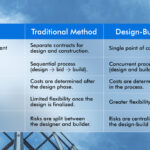Running a construction business requires keeping track of multiple moving parts, from project management to financial tracking and resource allocation.Construction software that suits your business will enable the streamlining of operations and enhance efficiency while minimizing mistakes that cost money.
Selecting appropriate construction software from the available options remains a fundamental challenge for businesses.The following guide shows you which elements need evaluation when choosing construction software to fulfill your requirements while driving business expansion.
With the right construction software, you can streamline processes, improve efficiency, and reduce costly errors. But with so many options available, how do you choose the best construction software for your business?
Identify Your Business Needs
You must first determine the precise requirements of your business before starting your software search. An organization’s construction software solutions can perform activities ranging from project management to accounting and bidding and estimation to resource management and collaborative work. The implementation of project management software allows you to monitor progress and schedule management and finish projects in a timely manner.
The combination of accounting and financial tools provides tools for budget preparation while handling cost estimation and invoicing functions and payroll operations. Software tools that integrate estimation capabilities will make project bidding faster and more precise when you perform frequent bids.
The monitoring of available materials and machinery and workforce levels becomes possible through resource management tools. Collaboration between project managers and their clients and contractors depends on the availability of proper communication tools. The identification of your weak areas enables you to choose specific software options that resolve your business needs.
Consider User-Friendliness
A software tool succeeds based on the natural adaptability of your team members. Operation speed decreases because complicated software systems require extensive learning to function effectively. This leads users to become frustrated. The adoption process becomes smoother when selecting software that presents an intuitive interface together with easy navigation.
Software providers give potential customers free trial periods and demonstration versions to evaluate system usability prior to purchase commitment. The time your team spends on using your software will decrease while the number of errors decreases when the software has an easy-to-use interface.
Look for Integration Capabilities
The software program you choose needs to connect effortlessly to all other digital tools that your company currently operates. The integration capabilities of your construction software must be tested to ensure connection with existing business tools including QuickBooks accounting software and Trello project management and CRM systems.
A connected system eliminates manual data handling which reduces human errors while creating unified data movements across organization sections. A system that integrates with other tools improves operational efficiency and maintains continuous business operations.
Cloud-Based vs. On-Premise Software
Your business needs determine which type of construction software will work for you since software exists in both cloud-based and on-premise formats. Cloud-based software lets users access data from anywhere and it runs updates in real-time and automatically backs up information. Such software works best for organizations which maintain dispersed workforces or need system access from project sites.
Local server installation of on-premise software provides users with better data security control at the cost of initial purchase expenses and maintenance needs. Understanding both your business requirements for mobility and security needs will guide you in selecting the most suitable solution for your organization.
Evaluate Security & Data Protection
Safety of sensitive financial information alongside employee data together with project data demands top priority status in construction software management. Data security depends heavily on software selection that enables safe encryption of content to protect against cyber dangers.
Compare Pricing & Value for Money
The software prices fluctuate substantially based on its capability range and scalability parameters. The pricing model of software providers may consist of subscription plans which cost users either monthly installments or yearly fees or a single purchase of the software.
Users can access free basic functionality on certain platforms through freemium plans that charge users for advanced features. Before making a cost evaluation examine whether the software platform provides all needed capabilities as separate add-ons require additional payments. Training expenses and the future profitability of your investment should be among your calculation factors. Through proper software investment organizations achieve shortened work processes alongside error minimization which leads to increased operational performance.
Read Reviews & Get Recommendations
Before making a final decision, research customer reviews and seek recommendations from industry peers. Online platforms such as Capterra, G2, and Trustpilot offer real user feedback on various software options. Reviews contain valuable information about software capabilities together with its flaws and the reliability of customer service and its operational capacity.
Other construction business owners who use this software can offer you important first-hand information about their experiences with the product. Checking user reviews at this stage enables you to select products which match promises and achieve desired results.
Assess Mobile Compatibility
The mobility requirement becomes essential since many construction teams operate in remote locations. Software platforms which feature mobile applications and web interfaces enable project managers to modify progress and employees to track hours and teams to read project information live. Mobile-friendly software solutions enable efficient communication and collaboration between staff members who work both in offices and in the field thus keeping all teams connected.
Evaluate Customer Support & Training
Software challenges may still occur despite excellent software quality so project teams must rely on dependable customer support services. Review the support hours of the provider before you buy because they might offer 24/7 assistance or business hours support or restricted availability.
Review all accessible support communication methods which should include phone support and email and live chat and online discussion forums. Your team will learn to operate the software effectively through video tutorials and documentation and webinars which make up your training resources. Business operations remain uninterrupted because good customer support quickly resolves issues thus reducing maintenance periods and service interruptions.
Test the Software Before Committing
All construction software vendors enable potential clients to test their products through demo versions and free trials. Make use of available trial periods to determine whether the software meets your requirements. Check if the software has an intuitive interface and needed capabilities and examine its total operational abilities. The trial experience should involve important team members who will give feedback about their interactions with the software. The evaluation step enables you to decide with confidence before spending money on a purchase.
Final Thoughts
The selection of appropriate construction software generates substantial effects on operational efficiency along with business success rates. Your search for the right solution starts with need assessment followed by feature evaluation and user experience assessment and test runs before making your final decision to choose a productivity-enabling collaborative software. The best software choice goes beyond extensive features since it must align perfectly with your business requirements. Devote adequate time to research before investing in software which will drive your business growth through multiple years.





